| DongFeng 15 (CSS-6) Short-Range Ballistic Missile
中国DF-15(CSS-6)近程弹道导弹 Date:2013-10-26 Source:internet By:globalmil Viewed: |
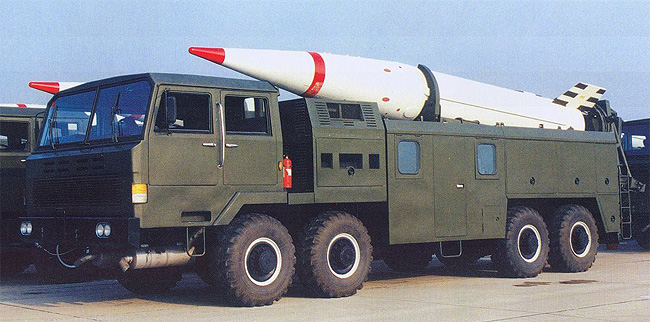
China’s most capable conventional short-range ballistic missile, the DF-15 is the mainstay of the PLA sub-strategic missile force.中国最有能力的常规近程弹道导弹,DF-15是PLA主要的局部-战略导弹力量。
The DongFeng 15 (Export name: M-9; NATO codename: CSS-6) is a solid-fuel, short-range ballistic missile (SRBM) system developed by CASC China Academy of Rocket Motor Technology (ARMT, also known as 4th Space Academy). The missile became famous during the 1996 Taiwan Strait crisis when the PLA launched several missiles as a warning to Taiwan’s independent trend. It is the only non-nuclear missile in service with the PLA Second Artillery Corps (strategic missile force). The improved variants DongFeng 15B and DongFeng 15C were spotted in service with the PLA recently.
东风-15(外销命名:M-9;北约代号:CSS-6)是一种固体燃料、近程弹道导弹(SRBM),由中国航天科技集团公司(CASC)下属的中国航天动力技术研究院(ARMT,第4空间研究院)发展。导弹在1996年台海危机期间出名,当时PLA发射了几枚导弹警告台湾地区的独立倾向。它是PLA第二炮兵(战略导弹力量)服役中唯一的非核导弹。改进型东风-15B和东风-15C被看到最近在PLA服役中。
The DongFeng 15 SRBM development began in 1985, and the design proposal was approved by the PLA in 1987. The first test launch took place in June 1987. From the late 1980s to the early 1990s, a range of test launches were conducted in the Gobi Desert in the northwest region of China. Some reports claimed that at least one of these test launches was carried using a nuclear warhead, but this cannot be confirmed. The missile was displayed in the 1988 Beijing International Defence Exhibition. It is believed that a small number had already entered service with the PLA Second Artillery Corps as early as 1989.
东风-15型SRBM发展从1985年开始,设计提议在1987年被PLA批准。第一次试射在1987年6月进行。从1980年后期到1990年早期,一系列试射在中国西北部的戈壁沙漠中进行。一些报告宣称至少在这些测试发射中的一次携带使用一枚核弹头,但是这不能够确认。导弹在1988年北京国际防卫展览中被展示。一般认为1989年PLA第二炮兵已经部署少量的导弹。
The DongFeng 15 missile has been frequently spotted in PLA exercises since the mid-1990s.The 2007 US DoD Report to the Congress estimated that the current deployment of the DongFeng 15 missile is 300~350 missiles and 70~80 launcher systems. Although the missile was also given an export name M-9, it was never exported to any other country. The is mainly due to the restrictions of the he Missile Technology Control Regime (MTCR), which forbids the export of delivery systems and related technology for those systems capable of carrying more than 500kg payload over a range of 300km or above.
东风-15导弹已经从1990年中期以后经常在PLA演习中看到。2007年美国防部向国会报告估计东风-15导弹目前部署300~350枚导弹和70~80套发射系统。虽然导弹也赋予一个M-9型外销命名,它从没有被输出到任何其他的国家。那主要地是由于“导弹及其技术控制制度”(MTCR)的限制,禁止出口递送系统和相关技术用于那些能够携带超过500公斤负载超过300公里射程的系统。
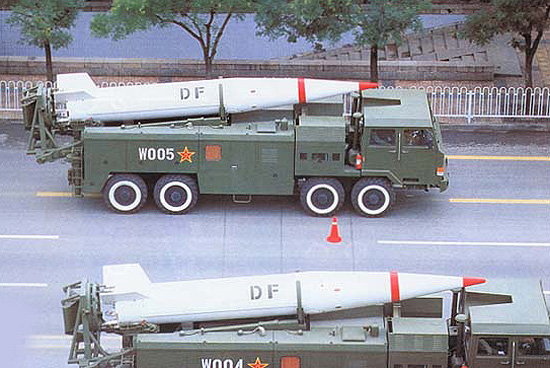
The DF-15 short-range ballistic missile system displayed during the 1999 National Day military parade.DF-15近程弹道导弹系统在1999年国庆阅兵式期间展示。
Design
The DongFeng 15 is a road-mobile, single-stage, solid-propellant, short-range ballistic missile system. The missile carries a 500kg single warhead and has a maximum range of 600km. Compared to China’s first generation liquid-propellant surface-to-surface missiles, the use of more advanced solid-fuel motor has significantly reduced the maintaining and pre-launch preparing time.
设计
东风-15是一种公路机动、单级、固体推进剂、近程弹道导弹系统。导弹携带500公斤单一弹头和最大射程600公里。比拟中国的第一代液体推进地对地导弹,使用更先进的固体发动机已经重要地减少保养和发射准备时间。
The missile is launched from a TAS5450 or WS2400 8X8 transporter-erector-launcher (TEL) vehicle to provide full road and cross-country mobility. In time of crisis the missile system could be quickly mobilised from bases to launch locations by railway. The TEL vehicle then carries the missile to the launch site with pre-calculated coordinate data.
导弹从一辆TAS5450型或WS2400型8X8运送-起竖-发射(TEL)车辆上发射提供全公路和越野机动性。导弹系统在紧急时期能用铁路从基地快速机动到发射位置。TEL车辆然后采用预先计算好的坐标数据携带导弹到发射位置。
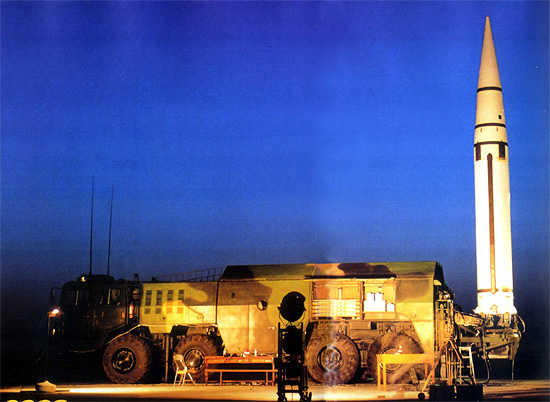
Carried on the 8X8 Tel vehicle for road and cross-country mobile, the DF-15 can be launched from any location with only 15~30 minutes pre-launch preparation.携带在8X8车辆上用于公路和越野机动,DF-15能够从任何发射地点使用仅仅15~30分钟预先发射准备。
Alternatively the missile can be launched from a unprepared new location by using GPS to obtain coordinate data. To increase the missile’s survivability in the combat, the support units could generate smoke to prevent it from being spotted by the enemy’s air-/space-based reconnaissance and surveillance systems. Mock missiles and TELs may also be deployed nearby as camouflage.
做为选择导弹能从一个新的无准备的发射位置使用全球定位系统去获得坐标数据。为了要增加在战斗中的导弹生存能力,支援单位能制造烟幕去防止被敌人的空中/天基侦察和监视系统发现。仿真的导弹和TEL也可能在附近部署用于伪装。
The DongFeng 15 can carry a single nuclear warhead, though the missile was designed mainly for the use in a conventional war. It has a range of warhead types including high-explosive, high-explosive incendiary, and armour-piercing cluster. Other warhead types under development include mine-laying, electromagnetic shockwave, and low-yield nuclear deep-penetration. With a terminal velocity of over Mach 6, the missile is difficult to intercept with any existing missile defence technology.
东风-15能携带一枚单一核弹头,虽然导弹被主要地用于一个常规战争使用设计。一系列弹头类型包括高爆、高爆燃烧和穿甲集簇弹药。在发展下的其它弹头类型包括布雷、电磁脉冲和低当量核深-侵砌。以超过6马赫的末端速度,导弹对任何已有的导弹防卫技术来讲拦截是困难的。
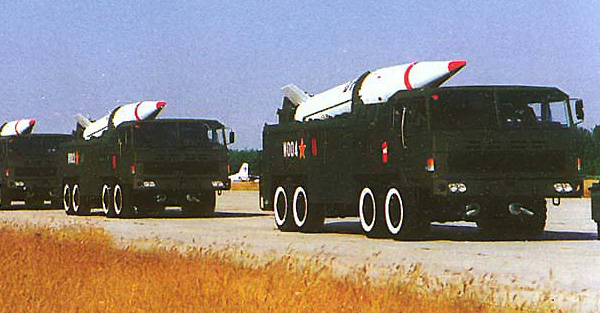
China’s most capable conventional short-range ballistic missile, the DF-15 is the mainstay of the PLA sub-strategic missile force.DF-15被期望装备多种类型弹头和成为中国主要依靠的局部-战略导弹力量。
At least two improved variants of the DongFeng 15 missile have been identified. The DongFeng 15B is fitted with four small fins at midsection for corrections at the final phase of the flight, while the DongFeng 15C has a cylinder shape second-stage possibly for extended range.
至少二种东风-15导弹的改型已经被识别。东风-15B在中部安装四个小稳定翼用于末段飞行修正,同时东风-15C采用圆筒形第二级可能用于增加射程。
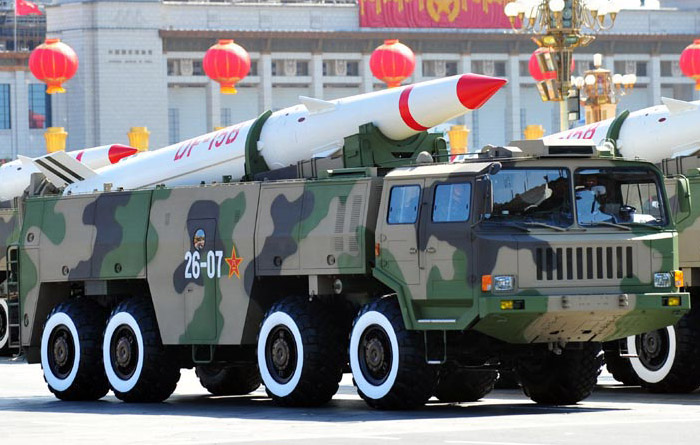
DongFeng 15B TEL vehicle (Chinese Internet).东风-15B运输-起竖-发射车辆(中国英特网)

DongFeng 15C with extended second stage (Chinese Internet).东风-15C采用增程第二级(中国英特网)
Guidance
The missile uses the inertial guidance, coupled to a faster on-board computer system to give a high accuracy. The early model has a circular error probable (CEP) of 300~600m, but various improvements on the guidance system has increased the accuracy of the missile to CEP 150~500m. This indicated that the PLA has already possessed the capability of launching a conventional precise-strike in the initial stage of the war to destroy enemy’s command & control centre, air defence missile sites, and airports.
制导
导弹使用惯性制导,连接到一部高速弹载计算机去提供高精确度。早期型拥有300~600米的圆概率误差(CEP),但是多方面改进制导系统把导弹的精度提高到圆概率误差(CEP)150~500米。这显示PLA已经拥有在战争最初阶段常规精确打击能力去摧毁敌人的指挥和控制中心,防空导弹位置和飞机场。
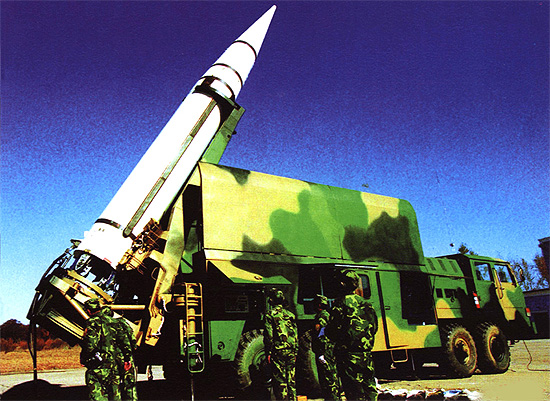
DF-15 in service with the PLA Second Artillery Corps. The DF-15 is China’s most advanced tactical short-range ballistic missile, offering a high accuracy which was not previously associated with Chinese-made ballistic missiles.DF-15在PLA第二炮兵服役中。DF-15是中国最先进的战术近程弹道导弹,提供以前中国制造的弹道导弹所不具有的一个高精确度。
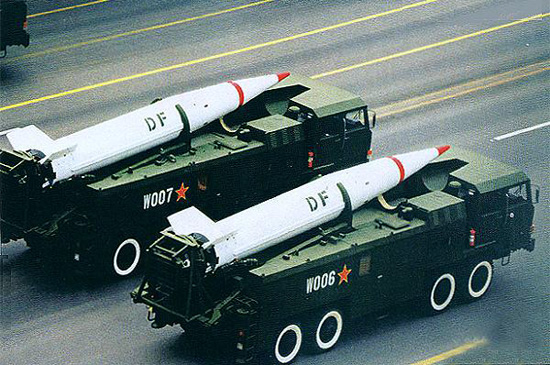
The DF-15 SRBM demonstrates the PLA’s capability to conduct long-range precision strike against enemy land targets. The PLA is also exploring the possibility of using theatre ballistic missiles against large surface targets such as air craft carrier battle group.DF-15近程弹道导弹(SRBM)示范PLA进行对抗敌人陆地目标的远程精确打击能力。PLA也正在研究使用战区弹道导弹对抗大型水面目标的可能性,像航空母舰战斗群。
China has also been reportedly seeking to further improve the accuracy of the DongFeng 15 missile by integrating it with the global positioning system (GPS) or a similar indigenously-developed satellite-based navigation and positing system. A terminal radar-guidance system is also under development. With both system onboard the missile’s accuracy may increase to CEP 35~50m.
中国也已经根据传闻寻求进一步改进DF-15导弹的精度,综合采用全球定位系统(GPS)或一个类似的本国自行发展卫星-基导航和定位系统。一套末段雷达-制导系统也在发展之下。导弹采用两者系统精度可能提高到圆概率误差(CEP)35~50米。
1995/96 Missile Tests
The PLA conducted two DongFeng 15 tests near the Taiwan Strait in 1995 and 1996 respectively. The New China News Agency announced the test launches shortly before they took place, and warned foreign aeroplanes and ships to avoid entering the target zones. During the first test launch taking place from 21 to 23 July 1995, a total of six missiles were launched from an unknown location in Fujian Province. All missiles were launched between 01:00 to 04:00 hours local time in the early morning to avoid hitting civilian aircraft and ships accidentally. 5 out of 6 missiles reportedly hit the target zone in the public water northwest of Taiwan.
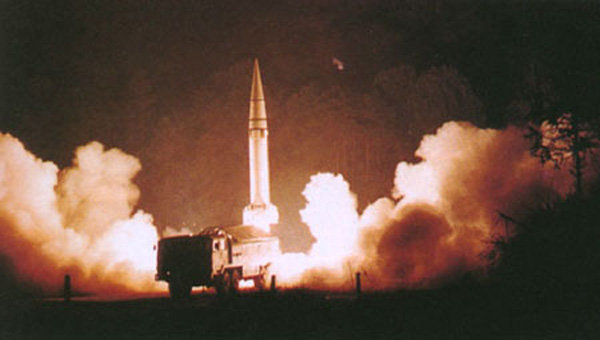
The PLA kept the DF-15 programme low profile until the mid-1990s, when two DF-15 test launches were conducted near the Taiwan Strait in 1995 and 1996 as a warning to Taiwan’s independent tendency.PLA低调保持DF-15计划直到1990年中期,1995年和1996年在台湾海峡附近进行两次DF-15测试发射当做对台湾独立倾向的一个警告。
1995/96年导弹试验
在1995年和1996年在台湾海峡附近PLA分别地进行了二次DF-15测试。为了避免外国的飞机和船只进入目标区,在试射前中国新华社提前向外界宣布。第一次试射安排在从1995年7月21日到23日,总数为六枚导弹从福建省的一个未知位置发射。所有的导弹发射在当地时间01:00到04:00清晨之间,去避免碰撞民航飞机和船只。6枚中有5枚导弹根据传闻击中了台湾公海水域西北目标区。
The second test launch took place in March 1996, with two target zones set in the public waters southwest and east of Taiwan respectively. In the early morning (00:00 local time) on 8 March, two missiles were launched almost simultaneously from two launch sites, and both hit two target zones. At around 01:00 local time, another missile was launched from one of the launch vehicles which were involved in the earlier launches to demonstrate its rapid reloading capability. On 12 March the fourth missile was launched and hit the scheduled target zone.
第二次试射在1996年3月进行,分别位于台湾公海水域西南和东部的二个目标区。在3月8日早晨两枚导弹几乎同时从二个发射位置发射,并且分别击中二个目标区。大概在当地时间08:00,另外的一枚导弹从一辆已经参与早期发射行动的发射车上发射,去示范它的快速再装填能力。在3月12日第四枚导弹被发射而且击中预定的目标区。
According to the US Navy intelligence, the missile launch and support troops involved in this operation were mobilised from their base in Jiangxi Province to the launch sites over a distance of several hundred kilometres, 60 hours prior to the scheduled launch time. About 20~30 DongFeng 15 missile systems took part in the operation.
依照美国海军的情报,包括在这个军事行动内的导弹和发射支援部队,在预定发射时间之前60个小时,从他们在江西省的基地机动超过几百公里距离到发射位置。大约20~30枚DF-15导弹系统参加军事行动。
Units
·815 Brigade
·816 Brigade
·817 Brigade
·818 Brigade
·819 Brigade
·820 Brigade
单位
·815 旅
·816 旅
·817 旅
·818 旅
·819 旅
·820 旅
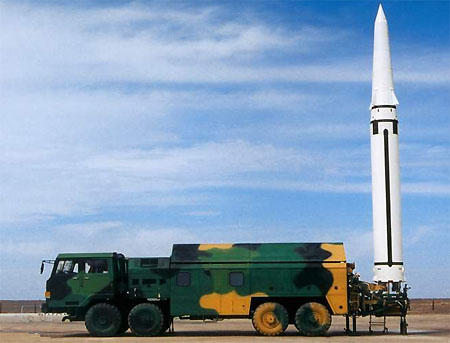
Specifications
Official name: DongFeng 15 (DF-15)
Export name: M-9
NATO reporting name: CSS-6
Contractor: CASIC 4th Academy
Service status: In service
Configuration: Single-stage (DF-15) or two-stage (DF-15B, DF-15C), solid propellant
Deployment: Road mobile, 6X6 tractor truck + six-wheel trailer; or silo
Length: 9.1m (DF-15)
Diameter: 1.0m
Launch weight: 6,200kg
Warhead: 500kg HE
Range: 600km (DF-15)
Guidance: Inertial + GPS
Accuracy: CEP 150~500m; or 30~50m on the later variants
Launch preparation time: 15~30 min
规格
正式命名: 东风-15(DF-15)
外销命名: M-9
北约代号: CSS-6
承包商: 中国航天科技集团公司第四研究院(航天动力技术研究院)
服役状态: 服役中
结构: 单级(DF-15)或二级(DF-15B,DF-15C),固体推进剂
配置: 公路机动,6X6牵引卡车+六轮拖车;或发射井
长度: 9.1 米(DF-15)
直径: 1.0 米
发射重量: 6,200 公斤
弹头: 500 公斤 HE
射程: 600 公里(DF-15)
制导: 惯性 + GPS
精度: CEP 150~500 米;或后来改型 30~50 米
发射准备时间: 15~30 分钟
Last update: 3 October 2009
最后更新: 2009年10月3日
上一篇:DongFeng 21C (CSS-5 Mod-3) Medium-Range Ballistic Missile 下一篇:DongFeng 11 (CSS-7) Short-Range Ballistic Missile
| DF-1 ballistic missile system
中国东风-1(DF-1)弹道导弹系统 |
| China’s first ballistic missile system, a licensed copy of the Soviet R-2 (SS-2 ‘Sibling’) short-range ballistic missile.... [2020-04-05] |
| B611 TACTICAL SURFACE-TO-SURFACE BALLISTIC MISSILE
中国B611战术地对地弹道导弹 |
| The B611 is the solid-fuel, surface-to-surface, short-range ballistic missile (SRBM) jointly developed by China Aerospace Science & Industry Corporation (CASIC) and Turkish weapon manufacturer MKEK.... [2017-01-15] |
| DF-21/A/C(CSS-5 Mod1/2/3)medium-range ballistic missile
中国东风-21/A/C型中程弹道导弹 |
| The DF-21 is a two-stage, solid-fuel rocket, single-warhead medium-range ballistic missile (MRBM) in the Dong Feng series developed by China Changfeng Mechanics and Electronics Technology Academy.... [2016-08-17] |
| DongFeng 31A (CSS-9 Mod-2) Intercontinental Ballistic Missil
中国DF-31A(CSS-9 Mod-2)洲际弹道导弹 |
| The DongFeng 31A (NATO reporting name: CSS-9 Mod-2) is a road-mobile, three-stage, solid-propellant intercontinental ballistic missile (ICBM), designed to carry a single 1,000kT thermal nuclear warhead.... [2016-01-04] |
